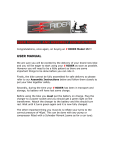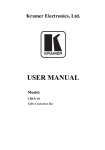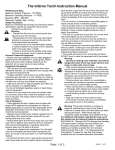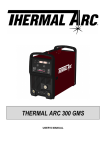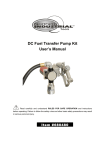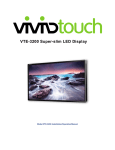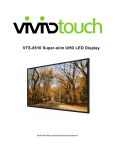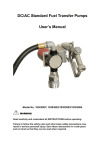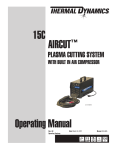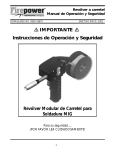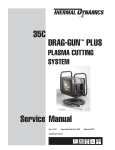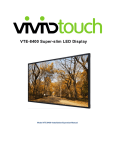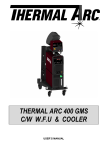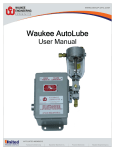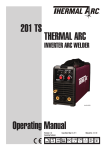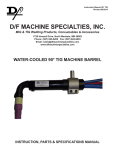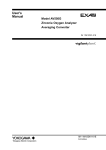Download 56-2990 PC 250 Instruction New
Transcript
PC250 Plasma Cutting System Instruction Manual FORM NO. 0056-2990 EFFECTIVE January 2004 IMPORTANT Safety and Operating Instructions For Your Safety . . . PLEASE READ CAREFULLY! Table of Contents Page Introduction . . . . . . . . . . . . . . . . . . . . . . . . . . . . . . . . . . . . . . . . . . . . . . . . . . . . . . . . . . . . . . . . . . . . . . . . . . 3 Safety . . . . . . . . . . . . . . . . . . . . . . . . . . . . . . . . . . . . . . . . . . . . . . . . . . . . . . . . . . . . . . . . . . . . . . . . . . . . . . . 3 Safety Profile . . . . . . . . . . . . . . . . . . . . . . . . . . . . . . . . . . . . . . . . . . . . . . . . . . . . . . . . . . . . . . . . . . . . . . 3 Safety Information . . . . . . . . . . . . . . . . . . . . . . . . . . . . . . . . . . . . . . . . . . . . . . . . . . . . . . . . . . . . . . . . . . 3 Safety Symbols . . . . . . . . . . . . . . . . . . . . . . . . . . . . . . . . . . . . . . . . . . . . . . . . . . . . . . . . . . . . . . . . . . . . . 3 Cautions and Warnings. . . . . . . . . . . . . . . . . . . . . . . . . . . . . . . . . . . . . . . . . . . . . . . . . . . . . . . . . . . . . . 4-6 Publications. . . . . . . . . . . . . . . . . . . . . . . . . . . . . . . . . . . . . . . . . . . . . . . . . . . . . . . . . . . . . . . . . . . . . . . . 7 Statement of Warranty . . . . . . . . . . . . . . . . . . . . . . . . . . . . . . . . . . . . . . . . . . . . . . . . . . . . . . . . . . . . . . . . . 8-9 Product Description . . . . . . . . . . . . . . . . . . . . . . . . . . . . . . . . . . . . . . . . . . . . . . . . . . . . . . . . . . . . . . . . . . . . 9 Specifications and Features . . . . . . . . . . . . . . . . . . . . . . . . . . . . . . . . . . . . . . . . . . . . . . . . . . . . . . . . . . . 10 Installation and Operation. . . . . . . . . . . . . . . . . . . . . . . . . . . . . . . . . . . . . . . . . . . . . . . . . . . . . . . . . . . . . . . 11 Site Location . . . . . . . . . . . . . . . . . . . . . . . . . . . . . . . . . . . . . . . . . . . . . . . . . . . . . . . . . . . . . . . . . . . . . . 11 Unpacking. . . . . . . . . . . . . . . . . . . . . . . . . . . . . . . . . . . . . . . . . . . . . . . . . . . . . . . . . . . . . . . . . . . . . . . . 11 Electrical Connection . . . . . . . . . . . . . . . . . . . . . . . . . . . . . . . . . . . . . . . . . . . . . . . . . . . . . . . . . . . . . 11-12 Operation . . . . . . . . . . . . . . . . . . . . . . . . . . . . . . . . . . . . . . . . . . . . . . . . . . . . . . . . . . . . . . . . . . . . . . . . 12 Functional Overview . . . . . . . . . . . . . . . . . . . . . . . . . . . . . . . . . . . . . . . . . . . . . . . . . . . . . . . . . . . . . . . . 12 Operating Control . . . . . . . . . . . . . . . . . . . . . . . . . . . . . . . . . . . . . . . . . . . . . . . . . . . . . . . . . . . . . . . 12-13 Getting Started . . . . . . . . . . . . . . . . . . . . . . . . . . . . . . . . . . . . . . . . . . . . . . . . . . . . . . . . . . . . . . . . . . . . 13 Torch Consumables Parts Selection . . . . . . . . . . . . . . . . . . . . . . . . . . . . . . . . . . . . . . . . . . . . . . . . . . . . . 14 Operating Tips . . . . . . . . . . . . . . . . . . . . . . . . . . . . . . . . . . . . . . . . . . . . . . . . . . . . . . . . . . . . . . . . . . . . . . . 15 Hand Torch Operation . . . . . . . . . . . . . . . . . . . . . . . . . . . . . . . . . . . . . . . . . . . . . . . . . . . . . . . . . . . . . . . 16 General Maintenance . . . . . . . . . . . . . . . . . . . . . . . . . . . . . . . . . . . . . . . . . . . . . . . . . . . . . . . . . . . . . . . . . . 17 Common Operating Faults . . . . . . . . . . . . . . . . . . . . . . . . . . . . . . . . . . . . . . . . . . . . . . . . . . . . . . . . . 17-18 Inspection and Replacement Consumable Parts . . . . . . . . . . . . . . . . . . . . . . . . . . . . . . . . . . . . . . . . . 18-19 Basic Troubleshooting Guide . . . . . . . . . . . . . . . . . . . . . . . . . . . . . . . . . . . . . . . . . . . . . . . . . . . . . . . 19-20 Parts List . . . . . . . . . . . . . . . . . . . . . . . . . . . . . . . . . . . . . . . . . . . . . . . . . . . . . . . . . . . . . . . . . . . . . . . . . . . 21 Spare Parts . . . . . . . . . . . . . . . . . . . . . . . . . . . . . . . . . . . . . . . . . . . . . . . . . . . . . . . . . . . . . . . . . . . . . . . 22 Ordering Info . . . . . . . . . . . . . . . . . . . . . . . . . . . . . . . . . . . . . . . . . . . . . . . . . . . . . . . . . . . . . . . . . . . . . 22 INTRODUCTION This User’s Manual provides specific information about your Firepower PC250 Plasma Cutting System. It provides pertinent information needed to safely and effectively operate your Firepower Plasma Cutting System. The manual provides instructions on set-up, installation and actual use. SAFETY SAFETY PROFILE Tradesmen respect the tools and equipment with which they work. They are also aware that tools and equipment are dangerous if used improperly or abused. Read this manual prior to using your Firepower machine. It will enable you to do a better and safer job. You will also learn the machine’s application, limitations and the potential hazards specific to plasma cutting. SAFETY INFORMATION The following safety information is provided to you as a guideline. Use it to operate your new Firepower Plasma Cutting System under the safest possible conditions. Any equipment that uses electrical power is potentially dangerous to use when the safety or safe handling instructions are not known and/or are not followed. This safety information gives you the necessary information for safe use and operation. Items in this manual that significantly affect safety are identified with the following headings. Please read and understand this manual. Pay special attention to items identified with these headings. WARNING - Means there is a possibility of injury or death to yourself or others if the proper safety precautions are not followed. CAUTION - Means there is the possibility of damage to the Firepower System or other property. NOTICE - Indicates points of interest for more efficient and convenient installation or operation. It may be used before or after a procedure to highlight or better explain the step. READ ALL SAFETY AND WARNING INSTRUCTIONS CAREFULLY before attempting to install, operate or service this machine. Your failure to comply with the instructions could result in personal injury and/or property damage. IMPORTANT RETAIN THESE INSTRUCTIONS FOR YOUR FUTURE REFERENCE. SAFETY SYMBOLS Please familiarize yourself with the warning symbols listed on the following pages. These symbols identify important safety messages in this manual. When you see one of these symbols, be alert to the possibility of personal injury and carefully read the message that follows. Indicates that the possibility of electric shock hazard exists during the operation of the step(s) that follow. Indicates that the possibility of fire hazard exists during the operation of the step(s) that follow. 3 Indicates that the helmet must be worn during the step(s) that follow to protect against eye damage and burns due to flash hazard. Indicates that the possibility of toxic gas hazard exists during operation of the step(s) that follow. Indicates that the possibility of being burned by hot slag exists during operation of the step(s) that follow. Indicates that eye protection should be worn to protect against flying debris in the following step(s). Indicates that the possibility of injury or death exist due to improper handling and maintenance of compressed gas cylinders or regulators. NOTES, CAUTIONS AND WARNINGS WARNING OPERATION AND MAINTENANCE OF PLASMA ARC EQUIPMENT CAN BE DANGEROUS AND HAZARDOUS TO YOUR HEALTH. Plasma arc cutting produces intense electric and magnetic emissions that may interfere with the proper function of cardiac pacemakers, hearing aids, or other electronic health equipment. Persons who work near plasma arc cutting applications should consult their medical health professional and the manufacturer of the health equipment to determine whether a hazard exists. To prevent possible injury, read, understand and follow all warnings, safety precautions and instructions before using the equipment. Call your local distributor if you have any questions. ELECTRIC SHOCK CAN KILL! The plasma arc process uses and produces high voltage electrical energy. This electric energy can cause severe or fatal shock to the operator or others in the workplace. Never touch any parts that are electrically "live" or "hot." Wear dry gloves and clothing. Insulate yourself from the work piece or other parts of the welding circuit. Repair or replace all worn or damaged parts. Extra care must be taken when the workplace is moist or damp. Install and maintain equipment according to NEC code. Disconnect power source before performing any service or repairs. 4 FIRE OR EXPLOSION CAN CAUSE DEATH, INJURY AND PROPERTY DAMAGE! Fire and explosion can be caused by hot slag, sparks, or the plasma arc. Be sure there is no combustible or flammable material in the workplace. Any material that cannot be removed must be protected. Ventilate all flammable or explosive vapors from the workplace. Do not cut or weld on containers that may have held combustibles. Provide a fire watch when working in an area where fire hazards may exist. Hydrogen gas may be formed and trapped under aluminum workpieces when they are cut underwater or while using a water table. DO NOT cut aluminum alloys underwater or on a water table unless the hydrogen gas can be eliminated or dissipated. Trapped hydrogen gas that is ignited will cause an explosion. Remember, cutting by nature produces sparks, hot spatter, molten metal drops, hot slag and hot metal parts that can start fires, burn skin and damage eyes. ARC RAYS CAN INJURE EYES AND BURN SKIN! Plasma Arc Rays can injure your eyes and burn your skin. The plasma arc process produces very bright ultra violet and infra red light. These arc rays will damage your eyes and burn your skin if you are not properly protected. To protect your eyes, always wear a welding helmet or shield. Also always wear safety glasses with side shields, goggles or other protective eye wear. Wear welding gloves and suitable clothing to protect your skin from the arc rays and sparks. Keep helmet and safety glasses in good condition. Replace lenses when cracked, chipped or dirty. Protect others in the work area from the arc rays. Use protective booths, screens or shields. Use the shade of lens as suggested in the following per ANSI/ASC Z49.1: Minimum Protective Suggested Arc Current Shade No. Shade No. Less Than 300* 8 9 300 - 400* 9 12 400 - 800* 10 14 * * These values apply where the actual arc is clearly seen. Experience has shown that lighter filters may be used when the arc is hidden by the workpiece. 5 FUMES, GASSES AND VAPORS CAN CAUSE DISCOMFORT, ILLNESS AND DEATH! Gases and fumes produced during the plasma cutting process can be dangerous and hazardous to your health. Keep all fumes and gases from the breathing area. Keep your head out of the welding fume plume. Use an air-supplied respirator if ventilation is not adequate to remove all fumes and gases. The kinds of fumes and gases from the plasma arc depend on the kind of metal being used, coatings on the metal, and the different processes. You must be very careful when cutting or welding any metals which may contain one or more of the following: Antimony Chromium Mercury Arsenic Cobalt Nickel Barium Copper Selenium Beryllium Lead Silver Cadmium Manganese Vanadium For information on how to test for fumes and gases in your workplace, refer to item 1 in the Publications section in this manual. Use special equipment, such as water or down draft cutting tables, to capture fumes and gases. Do not use the plasma torch in an area where combustible or explosive gases or materials are located. Phosgene, a toxic gas, is generated from the vapors of chlorinated solvents and cleansers. Remove all sources of these vapors. Noise can cause permanent hearing loss. Plasma arc processes can cause noise levels to exceed safe limits. You must protect your ears from loud noise to prevent permanent loss of hearing. To protect your hearing from loud noise, wear protective ear plugs and/or ear muffs. Protect others in the workplace. Noise levels should be measured to be sure the decibels (sound) do not exceed safe levels. 6 PUBLICATIONS Refer to the following standards or their latest revisions for more information: 1. OSHA, SAFETY AND HEALTH STANDARDS, 29CFR 1910, obtainable from the Superintendent of Documents, U.S. Government Printing Office, Washington, D.C. 20402 2. ANSI Standard Z49.1, SAFETY IN WELDING AND CUTTING, obtainable from the American Welding Society, 550 N.W. LeJeune Rd, Miami, FL 33126 3. NIOSH, SAFETY AND HEALTH IN ARC WELDING AND GAS WELDING AND CUTTING, obtainable from the Superintendent of Documents, U.S. Government Printing Office, Washington, D.C. 20402 4. ANSI Standard Z87.1, SAFE PRACTICES FOR OCCUPATION AND EDUCATIONAL EYE AND FACE PROTECTION, obtainable from American National Standards Institute, 1430 Broadway, New York, NY 10018 5. ANSI Standard Z41.1, STANDARD FOR MEN'S SAFETY-TOE FOOTWEAR, obtainable from the American National Standards Institute, 1430 Broadway, New York, NY 10018 6. ANSI Standard Z49.2, FIRE PREVENTION IN THE USE OF CUTTING AND WELDING PROCESSES, obtainable from American National Standards Institute, 1430 Broadway, New York, NY 10018 7. AWS Standard A6.0, WELDING AND CUTTING CONTAINERS WHICH HAVE HELD COMBUSTIBLES, obtainable from American Welding Society, 550 N.W. LeJeune Rd, Miami, FL 33126 8. NFPA Standard 51, OXYGEN-FUEL GAS SYSTEMS FOR WELDING, CUTTING AND ALLIED PROCESSES, obtainable from the National Fire Protection Association, Batterymarch Park, Quincy, MA 02269 9. NFPA Standard 70, NATIONAL ELECTRICAL CODE, obtainable from the National Fire Protection Association, Batterymarch Park, Quincy, MA 02269 10. NFPA Standard 51B, CUTTING AND WELDING PROCESSES, obtainable from the National Fire Protection Association, Batterymarch Park, Quincy, MA 02269 11. CGA Pamphlet P-1, SAFE HANDLING OF COMPRESSED GASES IN CYLINDERS, obtainable from the Compressed Gas Association, 1235 Jefferson Davis Highway, Suite 501, Arlington, VA 22202 12. CSA Standard W117.2, CODE FOR SAFETY IN WELDING AND CUTTING, obtainable from the Canadian Standards Association, Standards Sales, 178 Rexdale Boulevard, Rexdale, Ontario, Canada M9W 1R3 13. NWSA booklet, WELDING SAFETY BIBLIOGRAPHY obtainable from the National Welding Supply Association, 1900 Arch Street, Philadelphia, PA 19103 14. American Welding Society Standard AWSF4.1, RECOMMENDED SAFE PRACTICES FOR THE PREPARATION FOR WELDING AND CUTTING OF CONTAINERS AND PIPING THAT HAVE HELD HAZARDOUS SUBSTANCES, obtainable from the American Welding Society, 550 N.W. LeJeune Rd, Miami, FL 33126 15. ANSI Standard Z88.2, PRACTICE FOR RESPIRATORY PROTECTION, obtainable from American National Standards Institute, 1430 Broadway, New York, NY 10018 7 FIREPOWER LIMITED WARRANTY SCOPE OF LIMITED WARRANTY: Firepower, a division of Thermadyne Industries, Inc. (hereinafter, "Seller") warrants that its products are free of defects in workmanship or material. If an authorized distributor or the customer of an authorized distributor (hereinafter, collectively, "Purchaser") who purchases Seller's product, notifies Seller within the time set forth below that the product has a defect in workmanship or material even though it has been stored, installed, operated, and maintained in accordance with Seller's specifications, instructions, recommendations and in accordance with recognized standard industry practice, and the product was not misused, repaired, neglected, altered, or damaged, the Seller may repair or replace, in its sole discretion, those parts of the product determined by Seller to be defective in workmanship or material if said defect is not attributable to Purchaser's acts or omissions. THIS WARRANTY EXCLUDES ANY WARRANTY OF MERCHANTABILITY, FITNESS FOR A PARTICULAR PURPOSE, OR OTHER WARRANTY OF QUALITY, WHETHER EXPRESSED, IMPLIED OR STATUTORY. LIMITED WARRANTY PERIOD: Except as otherwise limited below, this limited warranty is effective for twelve months from the date Seller sells the product to an authorized distributor, or for twelve months after an authorized distributor sells the product to its customer, whichever is longer, except that in no event will this warranty exceed eighteen months from the date the product is sold from Seller to an authorized distributor. Notwithstanding the foregoing, • Firepower oxygen / acetylene products will be covered by a two-year product replacement warranty • Firepower plasma cutting equipment will be covered by a one-year (parts & labor) warranty. • Firepower electric welding machines will be covered by the Firepower 5-2-1 limited warranty. • 5 years on the transformer • 2 years on the welding unit • 1 year on the MIG gun • Firepower engine-driven welding machines will be covered by a one-year (parts & labor) warranty. Engines will be covered by the manufacturer's warranty. • Firepower ADF (auto-darkening) welding helmets will be covered by a one-year warranty. Any ADF helmet claims must be made directly to Jackson / Morsafe products, Belmont, MI, 800-253-7281. • Firepower welding electrodes, MIG (& flux cored) wire, and brazing rods, although manufactured to AWS Class specifications, are considered perishable items. As, such, these products are sold "as is" and "with faults" and without warranty, either express or implied, including the warranties of merchant ability and fitness for a particular purpose. • Products used in rental applications are warranted for one year from the date sold by the Seller to an authorized distributor, without regard to when they were later sold by the authorized distributor. 8 LIMITED WARRANTY CLAIM METHOD: To make a claim under this warranty, Purchaser must notify Seller of the details of such claim within thirty days of discovering a defect in material or workmanship. If the claim is covered by this warranty, Seller will direct Purchaser to return the product to an authorized warranty repair center. The Seller will not be responsible for transportation costs or risks of any kind under this warranty. The Purchaser will be responsible for all such transportation costs and risks. LIMITATION OF LIABILITY: Seller shall not, under any circumstances, be liable for special, indirect, incidental or consequential damages (regardless of the form of action, whether in contract or in tort including negligence), including, but not limited to, damage or loss of other property or equipment, loss of profits or revenue, cost of capital, cost of purchased or replacement goods, or claims of Purchaser for service interruption. In no event will this warranty obligate Seller for any amount exceeding the price of the goods upon which liability is based. Correction of non-conformities, in the manner and time provided herein, constitutes fulfillment of all Seller's obligations to Purchaser with respect to Purchaser's purchase of Seller's product. This warranty is invalid if the product was sold by non-authorized entities. This warranty is invalid if replacement parts or accessories were used that in Seller's sole opinion impaired the safety or performance of seller's product. This warranty supersedes all previous warranties. PRODUCT DESCRIPTION The Firepower PC250 Plasma Cutting System includes the following: • 115V Power Supply/ 60 Hz • Power Supply provides 20 amps output cutting current. All electrical, pilot, and gas control circuitry is included. • EL-60 70° Hand Torch with 13 foot (4 m) Leads. Cut capacity is 1/4 inch (6.4 mm) steel. • EL-60 Torch Spare Parts: 2 Electrodes, 2 Cutting Tips. • 13 foot (4 m) Ground Cable with Clamp. • Units have an 6.5 foot (2 m) AC Input Power Cable with 20 amp Molded Plug (NEMA 5-20P). 9 SPECIFICATIONS FOR PC250 PLASMA CUTTING SYSTEM (1445-0927) Type Input Voltage Rated Output Input Amperage Agency Approval Maximum Output Cut Capacity Output Power Settings Panel LED Indicators Power Switch Power Cord Plasma Gun Ground Cable and Clamp Weight Power Supply Dimensions Configuration Leads Length Current Rating Duty Cycle Cutting Range Torch Parts Gas Type Air Pressure Power Supply 10 - 20 AMP Plasma Cutting System 115V (60Hz) 20A / 40% Duty Cycle 20A CSA 20A Most Materials up to 1⁄4" (6.4mm) Adjustable from 10 - 20 AMPs (Dial) Green: On, Initiate Arc, Overvoltage / Red: Output Voltage / Yellow: Air Pressure / Yellow: Temperature Indicator Illuminated ON/OFF Switch UL/CSA Listed 6.5 ft (2m) 20Amp Power Plug 13 ft (4m) Firepower EL60 13ft (4m) 200A Clamp ~ 24 lbs (10.6 KG) 17.72 x 5.91 x 12.20 inches (45 x 15 x 31 CM) Torch 70 Degree Head Angle 13 ft. (4m) 30 Amps, DC, Straight Polarity 100% 100% Most materials up to ⁄" (6.4mm) O-Rings, Electrode, Start Cartridge, Gas Distributor, Tip, Coil Spring, Shield Cup Air 50psi - 200CFH 10 INSTALLATION AND OPERATION SITE LOCATION CAUTION Select a clean, dry location with good ventilation and adequate working space around all components. Operation without proper air flow will inhibit proper cooling and reduce duty cycle. To prevent entry of cutting or other metal debris, the power supply must not be operated in the horizontal position. Operate the power supply in the vertical position only with the power supply control panel side up. The power supply is cooled by air flow through the side and end panels. Air flow must not be obstructed. Provide at least 12 inches (300 mm) clearance on each side. Provide sufficient clearance around top of the unit to allow access to top panel controls (minimum 12 inches or 300 mm). NOTE: Review the safety precautions in the front of this manual to be sure that the location meets all safety requirements. UNPACKING The system is packaged with a carton and packing material to prevent damage during shipping. A. System Components Included with each system is the following: (1) Power Supply with the following installed: • EL60 Torch and Leads (1 each) • Ground Cable with Clamp attached (1 each) • Single-Phase Input Power Cable with Plug attached (1 each) (1) Instruction Manual (1) Spare Parts Kit - includes: • Standard Tips (2 each) • Electrodes (2 each) B. Unpacking Procedure 1. Unpack each item and remove all packing material. 2. Locate the packing list(s) and use the list to identify and account for each item. 3. Inspect each item for possible shipping damage. If damage is evident, contact your distributor and/or shipping company before proceeding with system installation. ELECTRICAL CONNECTION A. Power Requirements 1. 115 VAC Units The unit will operate on single phase 115VAC, 60 Hz. The service must be fused for at least 20 amps. A 15 amp circuit is insufficient for proper system operation. 11 B. Extension Cords Extension cords must meet National Electric Code guidelines. Extension cords must be rated for at least 20 amps and must have three-prong plugs. Refer to the following table for recommended cord sizes: Extension Cord Wire Gauge Requirements Cord Length Wire Gauge 50 ft. (15.2 m) or less 12 gauge 100 ft. (30.5 m) 10 gauge 150 ft (45.7 m) 8 gauge CAUTION The primary power source, power cable, and plug all must conform to local electrical codes and recommended circuit protection and wiring requirements. Air supply must be free of oil, moisture, and other contaminants. Excessive oil and moisture CAUTION may cause double-arcing, rapid tip wear, or even complete torch failure. Contaminants may cause poor cutting performance and rapid electrode wear. The air pressure regulator assembly integrated in the machine is also an adequate filter and moisture trap. FUNCTIONAL OVERVIEW The Firepower PC250 Plasma Cutting System is designed to provide a plasma cutting system which can cut most metals from gauge thickness up to 1/4 inch (6.4 mm). OPERATING CONTROLS 1. ON/OFF Switch ON position supplies AC power to activate all system control circuits. OFF position deactivates control circuits. 2. Green LED After switching the unit on the green LED blinks for 5 seconds indicating condensors are in charge and the unit is getting ready for use. After 5 seconds the LED remains on and the unit is ready. The LED blinks for 3 seconds after having pressed and released the torch trigger. This is the time you have to press the trigger again and initiate the arc. Slow blinking green LED indicates that the unit is in overvoltage. The LED blinks for 10 seconds then it tests the line voltage for 2 seconds. If it is ok, it remains on. If it is not ok, procedure repeats until the voltage is ok. Figure A Controls and Indicators 12 3. Red LED Is illuminated when there is output voltage. 4. Cutting current potentiometer 5. Yellow LED Indicates there is not enough air pressure. Pressure must be adjusted from 4 to 6 bar maximum (57-86 psi). If 6 bar is exceeded the internal solenoid valve releases air. 6. Yellow LED Blinks if the inside temperature reaches dangerous values. 7. Ground Cable 8. Plasma Cutting Torch 9. Air Pressure Regulator 10. Gauge 11. Cable clamp for input cable 2/4 TIMES FUNCTION: The machine is protected against the chance striking of the pilot arc. Bring the torch nozzle near the edge of the workpiece (3mm), press the torch button, release it and press it again within 3 seconds. After approximately 0.5 seconds (pre-air) the pilot arc is struck (max duration 3 seconds on air). If the distance is correct, the pilot arc immediately transfers to the workpiece causing the cutting arc to be struck. WARNING GETTING STARTED WARNING Disconnect primary power at the source before assembling or disassembling stacked modules, individual modules, torch parts, or torch and leads assemblies. A. Torch Parts Check the torch for proper assembly. Install proper torch parts for the desired application (refer to Section called Torch Consumable Parts Selection). NOTE: The power supply will not operate unless the torch shield cup is fully seated against the PIP (Parts in Place) pins in the torch head. B. Input Power 1. Check the power source for proper input voltage. 2. Make sure the power source meets circuit protection and wiring requirements. 3. Plug unit in and close main disconnect switch to supply primary power to the system. C. Ground Cable Check for a solid ground cable connection to the workpiece. D. Purge System Place the ON/OFF switch to the ON position. The ON light will flicker momentarily as the system powers up and then stays on. Activate the torch button to initiate gas purge (pre-flow) to will remove any condensation that may have accumulated in the torch and leads while the system was shut down. When the gas purge is complete, pilot arc will be initiated. WARNING DO NOT initiate pilot arc during adjustment. E. Checking Air Quality To check air quality, deactivate the torch (post-flow) and place a welding filter lens in front of the torch. Any oil or moisture in the air will be visible on the lens. WARNING DO NOT initiate pilot arc while checking air quality. F. Ready for Operation The system is now ready for operation. 13 TORCH CONSUMABLE PARTS SELECTION Part # Description 1445-0928 1445-0929 1445-0930 1445-0931 1445-0932 1445-0933 1445-0934 1445-0935 1445-0936 1445-0937 1445-0938 1445-0939 70deg Torch, 4m (13ft) Leads Lead Assembly, 4m (13ft) Leads 70deg Torch Head O-Ring O-Ring O-Ring Electrode, Air/N2 Start Cartridge Gas Distributor Tip, Cutting, Air/N2 Coil Spring Shield Cup, std Pkg Qty 1 1 1 5 5 5 5 1 1 5 5 1 To change the torch consumable parts use the following procedure: NOTE The tip, gas distributor, and electrode are held in place by the shield cup. Position the torch with the shield cup facing upward to prevent these parts from falling out when the cup is removed. 1. Unscrew and remove the shield cup from the Torch Head Assembly. Figure B Consumable Parts. 2. Remove the tip, gas distributor, and electrode. 3. Install the electrode, gas distributor, and tip. Gas Standard Electrode Distributor Tip Shield Cup 4. Hand tighten the shield cup until it is seated on the torch head. If resistance is felt when installing the A-00780 Torch Head Assembly cup, check the threads before proceeding. Figure B Consumable Parts CAUTION Improper assembly or use of non standard torch parts can cause the torch head to short and may overheat or damage the torch. 14 OPERATING TIPS A. Piloting Piloting is harder on parts life than actual cutting because the pilot arc is directed from the electrode to the tip rather than to a workpiece. Whenever possible, avoid excessive pilot arc time to improve parts life. B. Torch Standoff Improper standoff (the distance between the torch tip and workpiece) can adversely affect tip life as well as shield cup life. Standoff may also significantly affect the bevel angle. Reducing standoff will generally result in a reduced bevel angle. C. Edge Starting NOTE Edge starting is not recommended for machine type operations as most of the operations use the standoff method of starting and finishing on the work piece. For edge starts, hold the torch perpendicular to the workpiece with the front of the tip near(not touching) the edge of the workpiece at the point where the cut is to start. When starting at the edge of the plate, do not pause at the edge and force the arc to "reach" for the edge of the metal. This effect will cause reduced tip life. Establish the cutting arc as quickly as possible. D. Direction of Cut In the Torch, the plasma gas stream swirls as it leaves the torch to maintain a smooth column of gas. This swirl effect results in one side of a cut being more square than the other. Viewed along the direction of travel, the right side of the cut is more square than the left (Refer to Figure below). To make a square-edged cut along an inside diameter of a circle, the torch should move counterclockwise around the circle. To keep the square edge along an outside diameter cut, the torch should travel in a clockwise direction. Left Side Cut Angle Right Side Cut Angle A-00512 Side Characteristics of Cut E. Dross When dross is present on carbon steel, it is commonly referred to as either "high speed, slow speed, or top dross". Dross present on top of the plate is normally caused by too great a torch to plate distance. "Top dross" is normally very easy to remove and can often be wiped off with a welding glove. "Slow speed dross" is normally present on the bottom edge of the plate. It can vary from a light to heavy bead, but does not adhere tightly to the cut edge, and can be easily scraped off. "High speed dross" usually forms a narrow bead along the bottom of the cut edge and is very difficult to remove. When cutting a troublesome steel, it is sometimes useful to reduce the cutting speed to produce "slow speed dross". Any resultant cleanup can be accomplished by scraping, not grinding. 15 HAND TORCH OPERATION A. Cutting with a Hand Torch 1. The torch can be comfortably held in one hand or steadied with two hands. Choose the technique that feels most comfortable and allows good control and movement. Position the index finger or thumb to press the control switch on the torch handle. 2. For edge starts, hold the torch perpendicular to the workpiece with the front of the tip on the edge of the workpiece at the point where the cut is to start. For piercing, angle the torch slightly to direct sparks away from the torch until the pierce is complete. 3. For drag cuts keep the torch in contact with the workpiece. For standoff cutting, hold the torch 1/16 -1/8 in (2-3 mm) from the work. 4. With the torch in starting position, press and hold the control switch. After an initial gas purge, the pilot arc will come on and remain on until the cutting arc starts. 5. Once on, the main arc remains on as long as the control switch is held down, unless the torch is withdrawn from the work or torch motion is too slow. If the cutting arc is interrupted, the pilot arc comes back on automatically. 6. To shut off the torch simply release the control switch. When the switch is released a ten second post-flow will occur. If the torch switch is closed during the post-flow, the cutting arc will restart immediately when the torch is brought within range of the workpiece. B. Piercing with a Hand Torch 1. When piercing with a hand torch, tip the torch slightly so that blowback particles blow away from the torch tip (and operator) rather than directly back into it. 2. Complete the pierce off the cutting line and then continue the cut onto the line. Hold the torch perpendicular to the workpiece after the pierce is complete. 3. Clean spatter and scale from the shield cup and the tip as soon as possible. Spraying or dipping the shield cup in anti-spatter compound will minimize the amount of scale which adheres to it. WARNING Disconnect primary power at the source before disassembling the torch or torch leads. Frequently review the Important Safety Precautions at the front of this Manual. Be sure the operator is equipped with proper gloves, clothing, eye and ear protection. Make sure no part of the operator's body comes into contact with the workpiece while the torch is activated. CAUTION Sparks from the cutting process can cause damage to coated, painted, and other surfaces such as glass, plastic and metal. NOTE Handle torch leads with care and protect them from damage. 16 GENERAL MAINTENANCE A. Cleaning Power Supply The only routine maintenance required for the power supply is a thorough cleaning and inspection, with the frequency depending on the usage and the operating environment. WARNING Disconnect primary power to the system before disassembling the torch, leads, or power supply. CAUTION Do not blow air into the power supply during cleaning. Blowing air into the unit can cause metal particles to interfere with sensitive electrical components and cause damage to the unit. To clean the unit, open the enclosure and use a vacuum cleaner to remove any accumulated dirt and dust. The unit should also be wiped clean. If necessary, solvents that are recommended for cleaning electrical apparatus may be used. CAUTION When cleaning care must be taken not to move or damage the electronic components. B. Cleaning Torch WARNING Disconnect primary power to the system before disassembling the torch, leads, or power supply. DO NOT touch any internal torch parts while the AC indicator light on the front panel of the power supply is ON. Even if precautions are taken to use only clean air with a torch, eventually the inside of the torch becomes coated with residue. This buildup can affect the pilot arc initiation and the overall cut quality of the torch. The inside of the torch should be cleaned with electrical contact cleaner using a cotton swab or soft wet rag. In severe cases, the torch can be removed from the leads and cleaned more thoroughly by pouring electrical contact cleaner into the torch and blowing it through with compressed air. CAUTION Dry the torch thoroughly before reinstalling. COMMON OPERATING FAULTS The following lists the more common cutting faults and what is the possible cause: 1. Insufficient Penetration a. Cutting speed too fast b. Torch tilted too much c. Metal too thick d. Worn torch parts e. Cutting current too low f. Non-Genuine Manufacturer's Parts 2. Main Arc Extinguishes a. Cutting speed too slow b. Torch standoff too high from workpiece c. AC line too low - reduce output current d. Work cable disconnected e. Worn torch parts f. Non-Genuine Manufacturer's Parts 17 3. Excessive Dross Formation a. Cutting speed too slow (bottom dross) b. Cutting speed too fast (top dross) c. Torch standoff too high from workpiece d. Worn torch parts e. Improper cutting current f. Non-Genuine Manufacturer's Parts 4. Short Torch Parts Life a. Oil or moisture in air source b. Exceeding system capability (material too thick) c. Excessive pilot arc time d. Air flow too low (incorrect pressure) e. Improperly assembled torch f. Torch tip contacting workpiece g. Damaged or loose torch head components h. Non-Genuine Manufacturer's Parts 5. Poor Pilot Starting a. Non-Genuine Manufacturer's Parts INSPECTION AND REPLACEMENT CONSUMABLE TORCH PARTS WARNING Disconnect primary power to the system before disassembling the torch or torch leads. DO NOT touch any internal torch parts while the AC indicator light on the front panel of the Power Supply is ON. Remove the consumable torch parts per the following procedure: NOTE The tip, gas distributor, and electrode are held in place by the shield cup. Position the torch with the shield cup facing upward to prevent these parts from falling out when the cup is removed. 1. Unscrew and remove the shield cup from the torch. NOTE Slag built up on the shield cup that cannot be removed may effect the performance of the system. Figure C Consumable Parts. Gas Standard Electrode Distributor Tip Shield Cup 2. Inspect the cup for damage. Wipe it clean or replace if damaged. A-00780 Torch Head Assembly 3. Remove the tip. Check for excessive wear Figure C Consumable Parts (indicated by an elongated or oversized orifice). Replace the tip if necessary. Figure D Tip Wear. 4. Remove the gas distributor. Check for excessive wear, plugged gas slots, or discoloration. Replace if necessary. Good Tip Worn Tip 5. Remove the electrode. Refer to Figure E and check the face of the electrode for excessive wear. The face of the electrode should not be recessed more than 0.10 inch (2.5 mm). If it is worn beyond this point it must be replaced. A-00323 Figure D Tip Wear 18 6. Install the electrode, gas distributor, tip and shield cup. 7. Hand tighten the shield cup until it is seated on the torch head. If resistance is felt when installing the cup, check the threads before proceeding. CAUTION Improper assembly or use of non standard torch parts can cause the torch head to short and may overheat or damage the torch. New Electrode Worn Electrode A-01270 Figure E Electrode Wear BASIC TROUBLESHOOTING GUIDE A. General Basic troubleshooting of the Firepower PC250 plasma cutting system can be performed without special equipment or knowledge, and without opening the enclosure. This basic troubleshooting guide covers input power, gas supply, and torch problems. For problems not covered here, refer to the Advanced Troubleshooting Guide or contact your authorized distributor. If a product must be returned for service, contact your authorized distributor. Materials returned to the Manufacturer without proper authorization will not be accepted. B. How to use this Guide The following information is a guide to help determine the most likely causes for various symptoms. This guide is set up in the following manner: X. Symptom (Bold Type) Any Special Instructions (Text Type) 1. Cause (Italic Type) a. Check/Remedy (Text Type) Locate your symptom, check the causes (easiest listed first) then remedies. Repair as needed being sure to verify that the unit is fully operational after any repairs. A. AC indicator OFF, Fan does not operate. 1. Circuit Breaker open. a. Reset Breaker. For 115 VAC Units use 20 amp or greater service. B. AC indicator ON, Over TEMP (temperature) indicator ON. 1. Unit is overheated. a. Make sure the unit has not been operated beyond 40% duty cycle limit. 2. Airflow obstructed. a. Provide at least 12 inch clearance on each side. 3. Shorted torch. TEMP indicator lights momentarily and unit shuts down. a. Check for proper torch parts assembly, or for shorted torch head. 19 C. AC indicator ON, Over TEMP (temperature) indicator not lighted, no gas flow in purge or pre-flow. 1. Gas not connected or pressure too low. a. Check source for at least 50 psi (3.5 BAR) during purge or pre-flow, adjust gas pressure to 50 psi. 2. Air filter or air line blocked, torch leads blocked. a. Replace filter cartridge. Check that air lines and torch leads are free of twists and kinks. D. AC indicator ON, Over TEMP (temperature) indicator not lighted, no gas flow when torch switch pressed. 1. Shield cup not properly installed on torch. a. Check that shield cup is fully seated against torch head. 2. Faulty Torch Switch or PIP Assembly in torch holder. a. Refer to Servicing Torch Head Components. 3. Faulty Main PC Board a. Repair/Replace Power Supply E. AC indicator ON, Over TEMP (temperature) indicator not lighted, gas flows. Torch does not pilot. 1. Faulty torch parts a. Inspect torch parts and replace if necessary. 2. Gas pressure too high. a. Set pressure to 50 psi (3.5 BAR). 3. Faulty main PC board. a. Repair/replace power supply. F. Torch pilots but does not cut. 1. Work lead not connected. a. Make sure work lead is connected securely to bare metal. 2. AC input power too low a. Use shortest service to breaker panel possible. Refer to specifications for PC250 for input power cable requirements. 3. Faulty Main PC Board a. Repair/Replace Power Supply 20 PARTS LISTS A. PC250 Power Supply Spare Parts Item No. Part Number 1 1444-0482 2 1445-0952 3 1445-0953 4 1445-0954 5 1445-0955 6 1444-0434 7 1445-0957 8 1445-0958 9 1445-0959 10 1445-0960 11 1444-0428 12 1445-0962 13 1445-0963 14 1445-0964 15 1445-0965 16 1445-0966 17 1445-0967 18 1445-0928 19 1445-0973 20 1445-0968 21 1445-0974 22 1445-0969 23 1445-0970 24 1445-0975 25 1445-0971 26 1445-0972 Power Supply Description ON/OFF SWITCH 16A 250V POTENTIOMETER KNOB D.32 BLACK FRONT VENT FRONT FRAME FRONT PANEL PC.BOARD PC 115V HANDLE DIVIDING PANEL AIR PRESSURE SWITCH 50psi PRESSURE REGULATOR M140 W/GAUGE 1/4" G - 1/4 NPT CONNECTOR GROMMET, CABLE CLAMP INPUT CABLE SJT 3XAWG14USA PLUG 115V 20A COVER PANEL GROUND CABLE 13 ft (6MM2) 200A CLAMP GROMMET, CABLE CLAMP GROUND CLAMP ART.261 - OK 150 RUBBER GROMMET 70DEG TORCH, 4M (13FT) LEADS TRANSFORMER CHOKE E65 100X0,18CU SOLENOID VALVE 115V 60HZ 1/8"G 3V COMPLETE P.C.BOARD PC 115V FAN REAR VENT LOWER PANEL PC 115V FOOT 21 Qty 1 1 1 1 1 1 1 1 1 1 1 1 1 1 1 1 1 1 1 1 1 1 1 1 1 2 B. PC250 Torch Spare Parts Part # Description 1445-0928 1445-0929 1445-0930 1445-0931 1445-0932 1445-0933 1445-0934 1445-0935 1445-0936 1445-0937 1445-0938 1445-0939 70deg Torch, 4m (13ft) Leads Lead Assembly, 4m (13ft) Leads 70deg Torch Head O-Ring O-Ring O-Ring Electrode, Air/N2 Start Cartridge Gas Distributor Tip, Cutting, Air/N2 Coil Spring Shield Cup, std Pkg Qty 1 1 1 5 5 5 5 1 1 5 5 1 C. Returns If a product must be returned for service, contact your authorized distributor. Materials returned to the Manufacturer without proper authorization will not be accepted. ORDERING INFORMATION Order replacement parts by catalog number and complete description of the part or assembly, as listed in the description column of the Parts List. Also include the model and serial number of the torch. Address all inquiries to your authorized distributor. 22 WORLD HEADQUARTERS: Suite 300, 16052 Swingley Ridge Road • St. Louis, MO 63017 • 636-728-3000 P. O. Box 1007 • Denton, TX 76202-1007 CUSTOMER SERVICE: 800-858-4232 • FAX 800-535-0557 International Customer Service Oakville, Ontario, Canada Ph: (1) 905-827-9777 Fax: (1) 905-827-9797 Thermadyne Canada Oakville, Ontario Canada Ph: (1) 905-827-1111 Fax: (1) 905-827-3648 Thermadyne Victor Brasil Rio de Janeiro, Brazil Ph: (55) 21-2-485-8990 Fax: (55) 21-2-485-8735 Form No. 0056-2990 (1/04) Thermadyne Europe Chorley, England Ph: (44) 1257-261755 Fax: (44) 1257-224800 Thermadyne Middle East Dubai, United Arab Emirates Ph: (971) 4-332-9060 Fax: (971) 4-332-5484 © Firepower, 2004 Thermadyne Asia Sdn. Bhd. Kuala Lumpur, Malaysia Ph: (603) 6092-2988 Fax: (603) 6092-1085 Thermadyne de Mexico Mexico City, Mexico Ph: (52) 55-5657-9494 Fax: (52) 55-5648-8805 Cigweld Australia Melbourne, Australia Ph: (61) 3-9474-7400 Fax: (61) 3-9474-7510 Thermadyne Japan Osaka, Japan Ph: (81) 6-4809-8411 Fax: (81) 6-4809-8412 www.firepoweronline.com Unique Welding Alloys Johannesburg, South Africa Ph: (27) 11-917-3600 Fax: (27) 11-917-8580 Thermadyne Chile Santiago, Chile Ph: (56) 2-557-2465 Fax: (56) 2-557-5349 Printed in U.S.A.
























